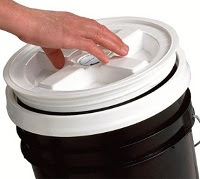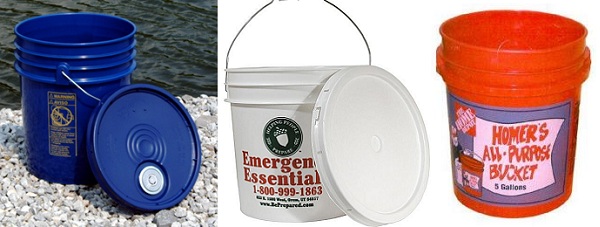Your emergency preparation kit will contain all sorts of essentials, but there’s one that comes right at the top of the list for versatility, convenience and all-round utility. That’s the humble 5-gallon bucket, available from any number of vendors, local or online.
You can get them for as little as $2.50 (bright orange ones from Home Depot – see the example on the right in the picture above), or less colorful examples for not much more. Lids are a couple of bucks extra. For less than $5, you can buy a simple bucket and a basic lid. For about $20, you can have a bucket, an airtight lid with gasket to hermetically seal the container, and a 5-gallon mylar bag plus a packet of oxygen absorber (or, if you prefer, several smaller mylar bags, each with its own oxygen absorber – such mylar bags make it unnecessary to buy buckets made of food-grade plastic, which are more expensive than standard buckets). Together, those items will provide safe, long-term food storage (up to 30 years, depending on the type of food involved). If you don’t like round buckets, or want to make more efficient use of space, you can get square buckets instead. Round or square, the buckets can be stacked on top of each other, several deep. They’re particularly useful to store many smaller items together, segregating them according to purpose and/or shelf life, and marking the buckets accordingly so you can locate the contents easily. (You can attach a paper label, or simply write on the bucket itself using a marker pen.)
 You can get regular lids, gasket lids, lids with pouring spouts or taps . . . whatever you need. (For long-term storage of perishable foodstuffs, even in mylar bags, in order to provide maximum protection against insects and for easy opening and re-sealing, I highly recommend fitting the bucket with a Gamma lid, shown at right. They’re relatively expensive, but very useful indeed.) If you have limited hand or arm strength, lid openers are available at low cost to make that job much easier. If you evacuate your primary dwelling, and need to camp out somewhere, you’ll definitely need emergency seating; and you can buy lids with padded tops to serve that purpose (some even swivel). Using your storage containers as seats kills two birds with one stone, so to speak. The buckets can be converted into a simple, low-cost drinking water filtration system for families or larger groups. You can use your buckets as work (even cooking) surfaces, either upright (with a suitable lid) or upside-down. They make convenient containers for tools (there are some nifty tool carriers that fit over them), and their handles make them easy to carry around from job to job. If the standard handles cut into your fingers or aren’t comfortable in any way, there are after-market grip handles to take care of that problem.
You can get regular lids, gasket lids, lids with pouring spouts or taps . . . whatever you need. (For long-term storage of perishable foodstuffs, even in mylar bags, in order to provide maximum protection against insects and for easy opening and re-sealing, I highly recommend fitting the bucket with a Gamma lid, shown at right. They’re relatively expensive, but very useful indeed.) If you have limited hand or arm strength, lid openers are available at low cost to make that job much easier. If you evacuate your primary dwelling, and need to camp out somewhere, you’ll definitely need emergency seating; and you can buy lids with padded tops to serve that purpose (some even swivel). Using your storage containers as seats kills two birds with one stone, so to speak. The buckets can be converted into a simple, low-cost drinking water filtration system for families or larger groups. You can use your buckets as work (even cooking) surfaces, either upright (with a suitable lid) or upside-down. They make convenient containers for tools (there are some nifty tool carriers that fit over them), and their handles make them easy to carry around from job to job. If the standard handles cut into your fingers or aren’t comfortable in any way, there are after-market grip handles to take care of that problem.
 You can even convert 5-gallon buckets (or the taller 6- or 7-gallon size, which will probably be more comfortable for larger people) into perfectly serviceable emergency toilets (essential if your local water and/or sewerage service is interrupted, or if you have to ‘bug out’ to a safer location). You don’t even need to buy expensive purpose-made toilet bags to line them. Simply use standard 13-gallon kitchen garbage bags. Pour a little kitty litter into each bag prior to use – it’ll absorb moisture and reduce unpleasant odors. When you’ve done your thing, tie up the bag and dispose of it.
You can even convert 5-gallon buckets (or the taller 6- or 7-gallon size, which will probably be more comfortable for larger people) into perfectly serviceable emergency toilets (essential if your local water and/or sewerage service is interrupted, or if you have to ‘bug out’ to a safer location). You don’t even need to buy expensive purpose-made toilet bags to line them. Simply use standard 13-gallon kitchen garbage bags. Pour a little kitty litter into each bag prior to use – it’ll absorb moisture and reduce unpleasant odors. When you’ve done your thing, tie up the bag and dispose of it.
All in all, I think that a suitable supply of 5-gallon buckets (plus lids and accessories, as outlined above) are an essential, fundamental element of any emergency preparedness kit. I recommend keeping at least 10-20 in stock, both for your own use and as valuable trading material in time of emergency. You’ll use them for any and all of the purposes listed above, and probably others I’ve not mentioned. You can even buy them in different colors – both the buckets themselves, and/or their lids – and thereby color-code your storage and/or use of them. Personally, I find this an extremely valuable feature. To be able to tell instantly, at a distance, by sight alone, without reading a label or lifting a lid, that this bucket contains food, that one holds drinking water, and the third one’s a toilet . . . that’s really useful! If your funds are limited, and you can only afford the cheaper, bright-orange buckets, you can still buy lids of different colors.
5-gallon buckets will be amongst your most useful and versatile emergency tools. If you don’t yet have a stash of them, plus lids and accessories, now would be a very good time to start building one.
Peter
(For more articles in this series, see the list in the sidebar or click here.)

For food storage, make sure you get 'food grade' specific buckets. I don't think those Home Despot specials are food grade. Should say so on the bottom of the bucket. Over here in Houston, Firehouse Subs sells their pickle buckets for $2 a piece and give the proceeds to local charity. They smell like dill pickles, but a good scrub and leave them in the sun to dry and the smell will go away. I use mine for a variety of purposes. Shipleys donuts used to give theirs away. Don't know if that's the case, but check with your local baker if they have any extras.
@Shooter: Yes, but only if you plan on putting loose food like rice, grain, etc. in direct contact with the bucket. If you store food in other containers (e.g. the bag it came in, or a Mylar food storage bag), you can put those into any type of bucket, without worrying about whether the latter is made of food-safe plastic.
For safety's sake, I prefer to store food in its own bag or container, rather than loose in a bucket.
This is a topic seldom discussed-containers. Every time I go to a museum I am reminded that humans have spent a great deal of time over the last few hundred thousand years making them, with enormous effort.
Remember the movie "The Gods Must be Crazy?)
Kitty litter often comes in useful buckets.
Y'all forgot the white buckets with gasketed lids and airlock grommets. You know, the ones that wine, beer, and mash get fermented in?
As far as non-food grade containers go, even with mylar bags, the answer is 'it depends': if the container is used, make sure the previous use was non-hazardous and not a solvent, even then I'm skeptical of using it for food storage, even with mylar bags.
Even with food grade containers, the previous occupant makes a difference – for instance pickle containers are notorious for imparting a smell to anything else packed in them unless cleaned extremely well. Some non-food items such as cloth, soap, sponges, etc will pick up odors from items they are stored with or in. Given the cost of used food buckets from grocery stores and restaurants, or new buckets, I don't think it is worth taking the chance of storing food in non-food grade buckets.
I like the idea of using multiple bags to store food in a bucket so that you don't have to open and expose all of the food at once. For items that are used less commonly, smaller containers can be used. For example, I've seen 5 gallon buckets of honey for sale – it would take most people a LONG time to use that much and handling it would be a mess; 1 to 3 lb containers will be much easier to handle and it is likely there will be less loss due to spillage/ handling as well.